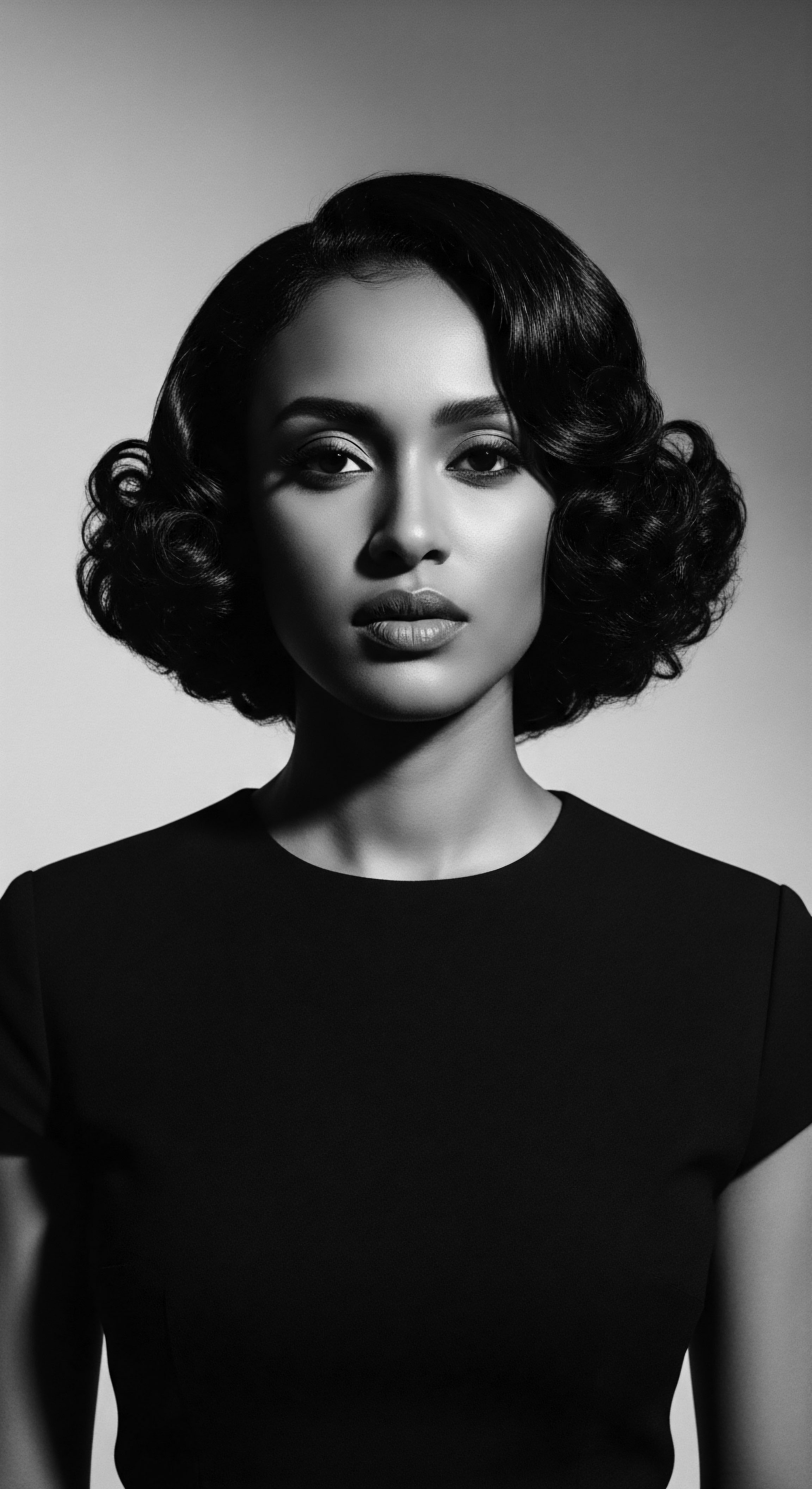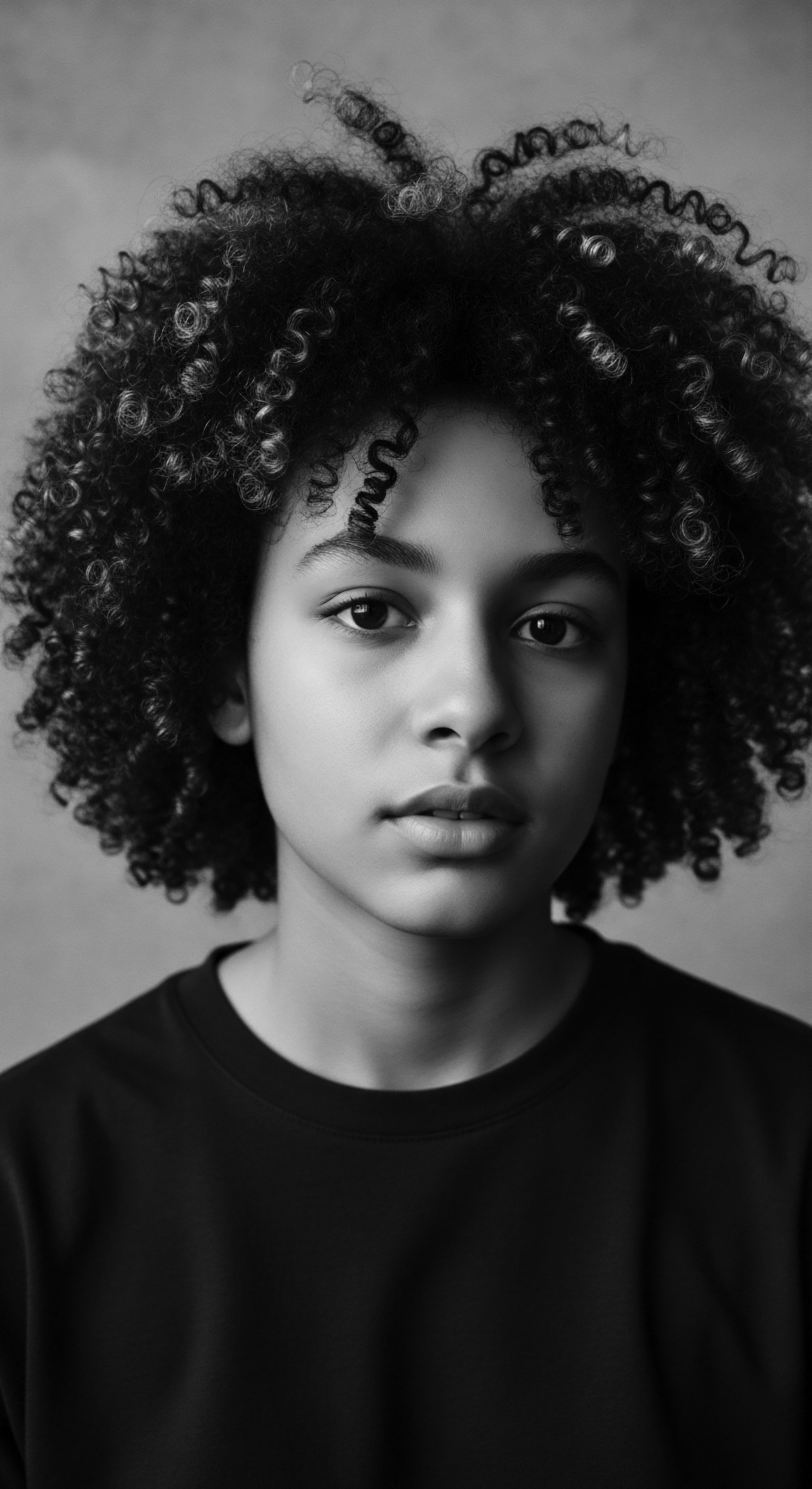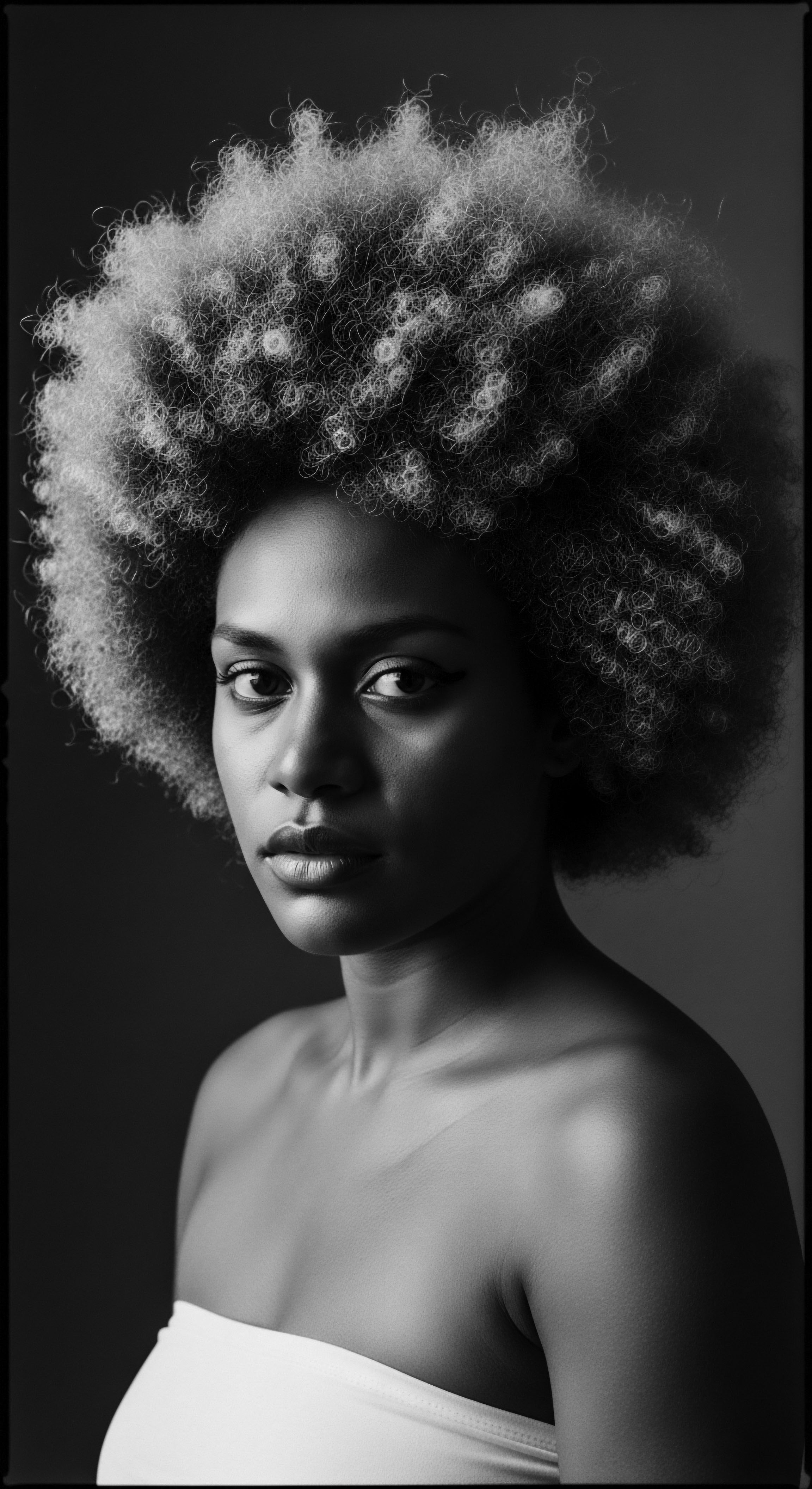
Fundamentals
The concept of Topical Hair Care, at its most elemental, refers to the application of substances directly onto the hair strands or the scalp. This practice aims to influence the hair’s condition, appearance, or the health of the follicular environment through external means. It is a fundamental aspect of grooming across human civilizations, a direct engagement with our physical selves, and for textured hair, it carries a profound historical resonance. The direct application of nourishment, protection, or styling agents to the hair and scalp forms the basis of this practice, offering a tangible connection between human ingenuity and natural resources.
Across diverse communities, the interpretation of Topical Hair Care’s meaning shifts, though its core function remains consistent ❉ to address the specific needs of the hair and scalp. For some, it is a straightforward process of cleansing and conditioning. For others, particularly within communities rich in ancestral hair traditions, it is a deeply considered ritual, a moment of connection with lineage and self. This initial understanding of Topical Hair Care serves as a gateway to appreciating its broader significance, especially as it intersects with the lived experiences and cultural expressions of Black and mixed-race individuals.
Topical Hair Care involves direct application to hair or scalp, a practice rooted in human history and carrying deep cultural weight, particularly for textured hair.
From the earliest human settlements, observations of nature informed early approaches to hair care. The soothing property of certain plant oils, the cleansing capability of specific clays, or the protective quality of animal fats would have been discovered through trial and sustained communal practice. This early understanding of Topical Hair Care was not codified in scientific journals but rather passed down through oral traditions, hands-on demonstration, and the collective wisdom of generations. These rudimentary yet effective topical applications laid the groundwork for the intricate care rituals that would develop within various cultures, each tailored to specific hair textures and environmental conditions.

Elemental Applications in Early Practices
Before complex formulations, Topical Hair Care began with simple, readily available elements. Consider the early uses of natural butters or mineral-rich earth. These substances, found in immediate surroundings, served as both protectors and conditioners for hair exposed to harsh climates. Their application was often intuitive, drawing from an inherent understanding of their physical properties.
- Plant Oils ❉ Derived from seeds or fruits, these provided lubrication and sealed moisture into the hair, guarding against dryness.
- Animal Fats ❉ Used for their emollient qualities, they offered a protective layer, particularly in colder environments or during periods of intense physical labor.
- Clays ❉ Earth-derived materials acted as gentle cleansers, drawing impurities from the scalp and hair without stripping essential moisture.
These foundational approaches to Topical Hair Care highlight humanity’s long-standing reliance on the earth’s bounty for self-preservation and adornment. The inherent wisdom in these practices, often refined over centuries, continues to offer valuable insights into maintaining hair health, especially for textured hair types that often require more moisture and protection. The initial designation of Topical Hair Care, therefore, extends beyond a mere cosmetic act; it embodies a heritage of resourcefulness and a bond with the natural world.

Intermediate
Elevating our understanding, Topical Hair Care can be seen as a conscious engagement with the surface biology of hair and scalp through thoughtfully chosen external agents. This practice transcends a simple application; it encompasses the purposeful selection of ingredients, the deliberate method of their delivery, and the intended physiological or aesthetic impact on the hair fiber and the dermal layer beneath. For textured hair, this has always held particular resonance, as its unique coil structure, often more prone to dryness and breakage, necessitates targeted topical interventions to preserve its integrity and vibrancy.
The meaning of Topical Hair Care thus expands to include the nuanced interplay between the applied substance and the hair’s inherent characteristics. Whether it is an oil designed to lubricate the cuticle, a cream formulated to provide hydration, or a scalp treatment intended to soothe irritation, each topical agent interacts with the hair at a molecular and structural level. This intermediate perspective asks us to consider not just what is applied, but how it functions in relation to the hair’s elemental composition and architectural form.

Living Traditions of Care and Community
Across ancestral pathways, particularly within African and Afro-diasporic communities, Topical Hair Care was rarely a solitary act. It represented a collective endeavor, a communal gathering where knowledge was exchanged, stories were shared, and bonds were strengthened. These traditions speak to a deep understanding of hair not just as a physical attribute, but as a living canvas of identity, spiritual connection, and social standing. The very act of care became a tender thread linking individuals to their lineage and community.
| Traditional Practice/Ingredient Himba Otjize (Ochre & Butterfat) |
| Ancestral Purpose (Historical Context) Symbolized status, age, lineage; offered sun/insect protection. |
| Modern Scientific Link/Counterpart Emollient butters provide moisture, while mineral pigments offer UV protection, a concept validated by contemporary photoprotection studies. |
| Traditional Practice/Ingredient Kpangnan Butter |
| Ancestral Purpose (Historical Context) Used for deep conditioning, soothing irritation, skin protection. |
| Modern Scientific Link/Counterpart Rich in fatty acids (oleic acid) and stigmasterol, scientifically recognized for moisturizing and anti-inflammatory properties. |
| Traditional Practice/Ingredient Ambunu (Chad) |
| Ancestral Purpose (Historical Context) Cleanser, detangler, scalp soother; promoted length retention. |
| Modern Scientific Link/Counterpart Plant-based saponins gently clean, while mucilage provides slip for detangling, mirroring modern sulfate-free cleansers and conditioners. |
| Traditional Practice/Ingredient African Black Soap |
| Ancestral Purpose (Historical Context) Deep cleansing, healing scalp ailments. |
| Modern Scientific Link/Counterpart Derived from plantain skins and oils, it contains natural saponins and emollients for effective, yet gentle, cleansing. |
| Traditional Practice/Ingredient These traditional applications for Topical Hair Care demonstrate an enduring ancestral wisdom that finds continued affirmation in contemporary understanding of hair science. |
The application of topical agents within these traditions was often an intimate process, passed down through generations. Grandmothers would meticulously oil and braid their grandchildren’s hair, imparting not only the technique but also the wisdom associated with each ingredient and style. This communal aspect imbued Topical Hair Care with a significance beyond mere physical maintenance; it became a ritual of intergenerational instruction and enduring affection.

The Sacred Act of Oiling and Styling
The systematic application of oils and butters holds a central place in the history of textured hair care. These natural emollients, sourced from the earth’s bounty, were applied not just to moisturize but to protect the hair from environmental rigors and to aid in styling. The consistency of these practices underscored a foundational understanding of hair porosity and moisture retention long before these terms entered scientific discourse.
- Lubrication ❉ Oils created a smooth surface, reducing friction between hair strands and preventing breakage during styling and daily wear.
- Sealing ❉ Butters, with their thicker consistency, were often used to seal in moisture, particularly for hair types prone to rapid dehydration.
- Protection ❉ A layer of topical product served as a barrier against sun, dust, and other environmental stressors, preserving the hair’s integrity.
Such applications, repeated consistently, formed the backbone of resilient hair health within communities whose hair was frequently misunderstood or devalued by external standards. The choice of ingredient often depended on local availability and specific needs, from the rich Shea Butter of West Africa to the lighter Marula Oil from Southern Africa. The communal act of styling, especially braiding, often involved the generous application of these topical agents, reinforcing the practical and symbolic roles of these practices. These sustained rituals speak to a profound, intuitive comprehension of hair’s needs, predating modern scientific nomenclature.

Academic
Topical Hair Care, from an academic vantage, refers to the systematic application of exogenous chemical compounds or botanical extracts to the hair fiber and scalp epidermis, aimed at modulating their physiological state, structural integrity, and aesthetic attributes. This definition acknowledges both the molecular interactions occurring at the hair surface and within the stratum corneum of the scalp, and the broader dermatological and cosmetic implications. The practice is understood not merely as an external treatment but as a complex interface between applied substances and the biological substrate, influenced by hair morphology, scalp microbiome, and environmental factors. For textured hair, this academic pursuit becomes a vital mechanism for deconstructing historical practices, validating ancestral knowledge, and developing formulations that respect the unique biomechanical properties of tightly coiled strands.
The rigorous investigation into Topical Hair Care’s efficacy requires an understanding of its meaning through the lens of biochemistry, trichology, and dermatological science. Each ingredient, whether a humectant, an emollient, or an active pharmaceutical agent, is analyzed for its penetration capabilities, its affinity for keratin, and its potential impact on cellular function within the hair follicle. Furthermore, the delivery system—be it a cream, oil, serum, or pomade—is scrutinized for its ability to optimize the deposition and retention of active compounds on the target site. This granular examination provides a scientific framework for comprehending how topical applications contribute to moisture retention, cuticle health, scalp homeostasis, and fiber resilience, especially critical considerations for hair with complex helical geometries.

Echoes from the Source ❉ The Himba Otjize and Its Enduring Legacy
To comprehend the profound interplay between ancestral practices and the contemporary understanding of Topical Hair Care, one might turn to the Himba people of Namibia. Their revered beauty ritual involving Otjize, a paste of red ochre and butterfat, offers a compelling case study. This isn’t merely a cosmetic application; it stands as a living archive of a sophisticated approach to topical hair care deeply interwoven with cultural identity, spiritual connection, and environmental adaptation.
The Himba women apply this distinctive preparation to their hair, shaping it into intricate dreadlocks that signify age, marital status, and social position within their community. The use of otjize is not merely a practice of adornment.
The butterfat component, often derived from cattle, provides a rich source of lipids, serving as a potent emollient. For Himba hair, which, like many textured hair types, is prone to dryness due to its coiled structure limiting the natural sebum distribution along the hair shaft, this butterfat delivers essential moisture and lubrication. The lipids coat the hair, reducing water loss from the cuticle layer and providing a protective barrier against environmental aggressors. This ancestral practice demonstrates an intuitive understanding of lipid-based topical applications for moisture retention and conditioning, a principle fundamental to modern hair science.
The red ochre, a mineral pigment, contributes not only to the iconic reddish hue but also offers a degree of photoprotection. Minerals, by their nature, can reflect and scatter ultraviolet (UV) radiation, thus safeguarding the hair and scalp from sun damage. This natural sun-screening property of ochre, combined with the barrier function of the butterfat, mitigated the harsh effects of the arid Namibian climate on both hair and scalp.
The Himba people’s otjize ritual exemplifies early topical hair care, blending butterfat’s emollient properties and ochre’s sun protection with profound cultural and ancestral meaning.
The communal application of otjize often involved women sharing this ritual, fostering social cohesion and the transmission of knowledge from elder to youth. This act of care, deeply embedded within the social fabric, reinforced collective identity and served as a tangible expression of shared heritage. The otjize practice thus provides a multi-dimensional insight into Topical Hair Care ❉ as a biomaterial science, an environmental adaptation, and a socio-cultural artifact.
It powerfully illustrates how early topical applications were not isolated acts of grooming but holistic engagements with well-being, appearance, and the spiritual world. The deep historical connection to this practice is detailed in works exploring the cultural heritage of African hair.
The Himba’s ritual with otjize, as chronicled by Sieber and Herreman (2000), exemplifies a profound understanding of topical agents. They demonstrate how external applications, even in ancient contexts, directly influenced the hair’s structural integrity and its ability to withstand environmental stress. The butterfat, rich in saturated and monounsaturated fatty acids, penetrates the hair shaft, providing internal lubrication and flexibility, while also sealing the cuticle to reduce moisture evaporation.
This directly correlates with contemporary trichological principles regarding the importance of emollients for maintaining the biomechanical strength of textured hair. The ochre component further highlights an ancestral awareness of physical protection.
This historical precedent challenges any narrow, Eurocentric view of cosmetic science, revealing that sophisticated topical solutions were developed and applied within African societies for millennia, driven by practical necessity, aesthetic aspiration, and a profound connection to the body and land. The knowledge encoded within the otjize ritual continues to inspire modern approaches to natural hair care, highlighting the enduring relevance of ancestral wisdom.

Interconnected Perspectives ❉ The Unbound Helix
The scope of Topical Hair Care extends beyond mere application; it represents a convergence of elemental biology and ancient practices. The journey from the earth’s raw gifts to sophisticated cosmetic formulations demonstrates a continuous thread of human ingenuity. Early communities intuitively recognized the protective qualities of certain plants and minerals, crafting rudimentary topical applications that served as foundational care. This initial, pragmatic understanding, often informed by necessity and observation, established a precedent for the ongoing development of hair care solutions.
From the communal spaces where hair was coiffed and stories were shared, to the modern laboratory where formulations are meticulously analyzed, Topical Hair Care has consistently been a medium through which identity is expressed and sustained. The communal act of braiding, often involving the liberal use of natural oils and butters, was not solely a styling endeavor; it was a deeply social ritual where knowledge of specific topical preparations and their benefits was passed down through generations. These practices cultivated a sense of belonging and reinforced cultural narratives.
The definition of Topical Hair Care, when viewed through a holistic lens, encompasses the entire journey of interaction between external agents and the hair. It spans the elemental understanding of ingredients, the historical evolution of their use, and the scientific elucidation of their mechanisms of action. This perspective is particularly resonant for textured hair, whose unique anatomical structure often necessitates a specific approach to topical applications for optimal health and appearance.

Deep Insights into Formulation and Function
The function of topical agents on textured hair is complex, owing to its distinct structural characteristics. The helical coiling of the hair strand, its elliptical cross-section, and the typically lower cuticle count contribute to increased surface area exposure and a tendency towards dryness. Therefore, topical applications for textured hair must be formulated with these specific needs in mind, emphasizing hydration, lubrication, and protective barrier formation.
- Humectants ❉ Ingredients like glycerin or hyaluronic acid draw moisture from the atmosphere into the hair shaft, improving pliability.
- Emollients ❉ Natural oils (e.g. coconut oil, castor oil) and butters (e.g. shea butter, kpangnan butter) smooth the cuticle and create a hydrophobic layer, reducing water loss.
- Protective Agents ❉ Film-forming polymers or protein derivatives can coat the hair, minimizing friction and mitigating damage from environmental stressors or styling tools.
The historical use of natural ingredients like Kpangnan Butter in West and Central Africa provides compelling evidence of this intuitive understanding. Rich in fatty acids and stigmasterol, Kpangnan butter has been applied topically for centuries to nourish hair, soothe irritation, and provide protection, exhibiting properties that modern scientific analysis now validates as anti-inflammatory and deeply moisturizing. This ancestral wisdom, honed through generations of empirical observation, predates contemporary cosmetic chemistry but aligns remarkably with its findings regarding lipid barriers and anti-inflammatory pathways.

Sociological Implications ❉ Hair as a Voice
Beyond the physiological, Topical Hair Care holds profound sociological significance for Black and mixed-race communities. Hair, and how it is cared for and presented, has historically served as a potent symbol of identity, resistance, and self-determination. From the deliberate cultivation of hairstyles that defied colonial impositions to the contemporary natural hair movement, topical products have been instrumental in allowing individuals to reclaim and express their heritage.
The early twentieth century in America saw a shift in hair care practices, influenced by a society that often valued straight hair as a marker of professionalism and beauty. Yet, even during this period, pioneers like Annie Malone and Madam C.J. Walker developed hair ‘growers’ and pressing oils that, while often facilitating straightening, also aimed to improve scalp health and hair growth, providing Black women with products tailored to their unique hair needs.
This entrepreneurial spirit created pathways for economic independence within the community and offered topical solutions that, for the first time, were conceived with Black hair in mind. The innovations provided women with tools to style their hair, allowing for personal expression in a challenging social climate.
The enduring value of these topical applications, whether ancestral butters or modern formulations, lies in their capacity to enable the expression of an unbound helix—hair that can be nurtured, protected, and celebrated in its natural form, affirming a rich and complex heritage. The careful tending of hair, through the application of topical agents, remains a powerful act of self-love and cultural affirmation within these communities.
The long-term impact of appropriate Topical Hair Care for textured hair extends to psychological well-being and cultural continuity. When individuals feel confident in the health and appearance of their hair, it reinforces self-esteem and a sense of belonging. The continuous adaptation of ancestral topical knowledge, refined by modern science, allows for the preservation of hair health and the honoring of identity across generations. This collaborative exchange between ancient wisdom and contemporary understanding offers a robust framework for approaching Topical Hair Care as a holistic endeavor.

Reflection on the Heritage of Topical Hair Care
As our contemplation of Topical Hair Care draws to a close, a compelling narrative emerges ❉ one of enduring heritage, of ancestral wisdom, and of an ever-evolving relationship between humanity and its most visible crown. The journey of Topical Hair Care for textured hair is more than a study of physical applications; it is a profound meditation on the resilience of cultural practices, the ingenuity of those who came before us, and the deep, soulful connection between hair and identity. From the elemental applications of butterfat and ochre by the Himba, connecting wearer to land and lineage, to the deliberate formulations of today, a continuous thread of care persists.
This journey reveals that Topical Hair Care is not a static concept but a living archive, breathing with the stories of generations who meticulously tended to their strands. The rhythmic application of oils, the patient sculpting of braids, the communal gatherings for shared grooming—each act, each ingredient, each moment, whispers of ancestral knowing. It reminds us that every strand, every coil, every unique texture carries within it the memory of a profound past, a testament to resilience and beauty. The careful tending of hair, through the application of topical agents, is not merely cosmetic; it is an act of veneration, a dialogue with our forebears.
The soul of a strand, indeed, reverberates with the echoes from the source. It is in the tender thread of hands-on care, passed down through time, that the deeper meaning of Topical Hair Care truly blossoms. It is in the recognition of its ancestral roots that we find its most potent power to shape futures, to affirm identities, and to celebrate the vibrant, unbound helix that is textured hair. This understanding compels us to approach hair care with reverence, acknowledging its historical weight and its capacity for fostering wellness and cultural pride.

References
- Byrd, Ayana D. and Lori L. Tharps. Hair Story ❉ Untangling the Roots of Black Hair in America. St. Martin’s Press, 2001.
- Caldwell, Kia Lilly. “Look at Her Hair” ❉ The Body Politics of Black Womanhood in Brazil. Transforming Anthropology, vol. 11, no. 2, 2003, pp. 18-35.
- Dabiri, Emma. Twisted ❉ The Tangled History of Black Hair Culture. Harper Perennial, 2020.
- Ellington, Tameka N. Black Hair in a White World. The Kent State University Press, 2023.
- Fashola, Joseph O. and Hannah Abiodun. “The Ontology of Hair and Identity Crises in African Literature.” IASR Journal of Humanities and Social Sciences, 2023.
- Akanmori, Harriet. “Hairstyles, Traditional African.” The SAGE Encyclopedia of African Cultural Heritage in North America. SAGE Publications, Inc. 2015.
- Sieber, Roy, and Frank Herreman. Hair in African Art and Culture. Museum for African Art, 2000.
